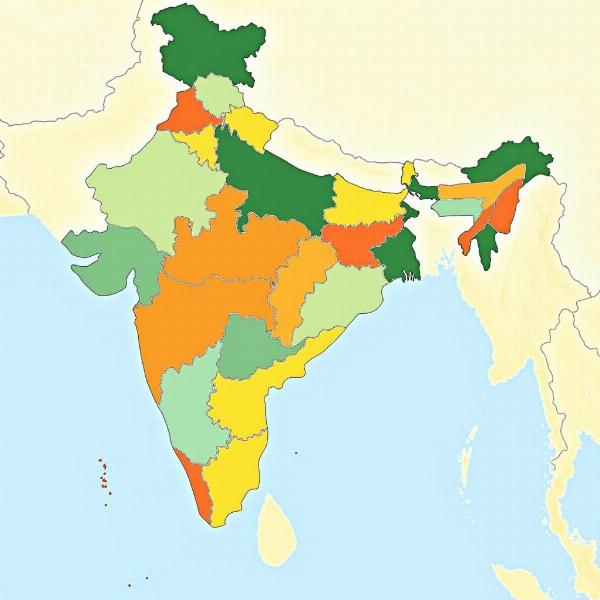Keyan, a seemingly simple word, can hold various meanings depending on context and regional variations within Hindi. Understanding its nuances is crucial for accurately interpreting and translating texts, conversations, and cultural expressions. This guide delves into the different interpretations of “keyan” in Hindi, providing examples and clarifying its usage in various scenarios.
Decoding the Multiple Meanings of “Keyan”
The word “keyan” isn’t a standard Hindi word found in dictionaries. It’s likely a colloquial or dialectical variation, possibly derived from more formal terms. Its most probable interpretations relate to “how,” “which,” “what kind of,” or even “why” in certain contexts. Let’s explore these possibilities:
- “How” (कैसे – kaise): In some dialects, “keyan” can be used interchangeably with “kaise” to inquire about the manner in which something is done. For example, “Keyan karoge?” translates to “How will you do it?”
- “Which” (कौन सा – kaun sa / कौन सी – kaun si): “Keyan” might also stand in for “kaun sa” or “kaun si” (masculine and feminine forms respectively) to ask about a specific choice among several options. For instance, “Keyan kitaab chahiye?” means “Which book do you want?”
- “What Kind of” (किस तरह का – kis tarah ka / किस तरह की – kis tarah ki): This interpretation focuses on the type or quality of something. “Keyan ghar hai?” would mean “What kind of house is it?”
- “Why” (क्यों – kyon): While less common, in some regional dialects, “keyan” can even express “why.” For instance, “Keyan aise kiya?” translates to “Why did you do this?”
Practical Examples of “Keyan” Usage
Understanding the subtle differences in meaning becomes clearer with practical examples:
- Scenario 1: Someone asking for directions might say, “Keyan jaoon?” meaning “How do I go?”
- Scenario 2: At a market, a vendor might ask, “Keyan sabzi leni hai?” meaning “Which vegetables do you want to buy?”
- Scenario 3: Describing a new car, someone might say, “Keyan gaadi kharidi hai!” meaning “What kind of car have you bought!”
- Scenario 4: (Less common) Expressing surprise, someone might exclaim, “Keyan itna late ho gaya?” meaning “Why are you so late?”
Regional and Dialectical Variations
The usage and interpretation of “keyan” vary considerably across different Hindi dialects. While common in certain regions, it might be entirely unfamiliar in others. This highlights the rich diversity within the Hindi language. For accurate communication, understanding the specific dialectal context is essential.
 Regional Variations of Keyan in Hindi
Regional Variations of Keyan in Hindi
Keyan in Everyday Conversations
Despite being informal, “keyan” plays a vital role in everyday conversations in certain Hindi-speaking communities. It adds a touch of familiarity and informality to communication. Mastering its usage can enhance your understanding and fluency in these dialects.
Why is understanding “keyan” important?
Understanding “keyan” is crucial for effective communication in specific Hindi dialects. It allows you to grasp the nuances of conversation and avoid misunderstandings.
How can I learn more about regional Hindi variations?
Exploring regional literature, interacting with native speakers, and immersing yourself in the local culture are excellent ways to learn more about the intricacies of different Hindi dialects.
Conclusion: Mastering the Nuances of “Keyan”
“Keyan” exemplifies the vibrant diversity within the Hindi language. Understanding its various interpretations, regional variations, and contextual usage enhances your comprehension and communication skills. By appreciating these nuances, you gain a deeper appreciation of the richness and complexity of Hindi.
FAQ:
- Is “keyan” a formal Hindi word? No, “keyan” is primarily used in informal conversations and specific dialects.
- What is the most common meaning of “keyan”? It most commonly translates to “how” or “which.”
- Can “keyan” be used in written communication? It’s generally avoided in formal written communication, but it can appear in informal writing or dialogues.
- Why is it important to understand dialectical variations in Hindi? Understanding dialects allows for effective communication and cultural sensitivity.
- Are there other similar colloquial terms in Hindi? Yes, Hindi has many colloquial variations depending on the region.
- How can I determine the correct meaning of “keyan” in a sentence? The context of the sentence and the speaker’s dialect are key to understanding the intended meaning.
- Where can I find more information about Hindi dialects? Linguistic resources, online forums, and interacting with native speakers can provide valuable insights into Hindi dialects.
Meaning-Hindi.in is your one-stop solution for all your Hindi translation needs. We specialize in various translation services, including business and commercial document translation, certified and legal document translation, technical and user manual translation, website and localization translation, educational and academic document translation, express translation, and specialized translation. Our expert linguists possess a deep understanding of Hindi grammar, literature, customs, and religions, ensuring accurate and culturally sensitive translations. For high-quality, reliable Hindi translation services, contact us at [email protected] or call us at +91 11-4502-7584. Meaning-Hindi.in is committed to delivering exceptional translation services tailored to your specific requirements.